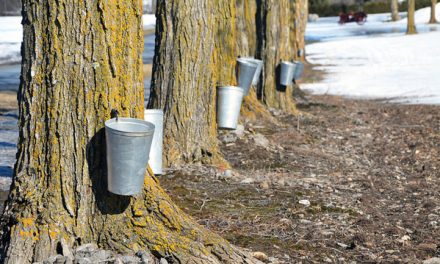Dr. Trevor Devries and Dr. Sandra Godden, the expert speakers at the 2020 Lactanet Herd Management Conference, offered advice for raising heifers efficiently and economically. Van Dusen photo
CRYSLER – Calf coddling was the main topic among four presentations offered during the 2020 Lactanet Herd Management Conference. The travelling conference was held in three Ontario locations: Crysler on Jan. 21, Tavistock Jan. 22, and Drayton Jan. 23. Speakers at all three were Dr. Sandra Godden of University of Minnesota’s Department of Veterinary Population Medicine, and Dr. Trevor Devries, of University of Guelph’s Department of Animal BioSciences.
About 120 participants turned out at the Crysler Community Centre for four sessions over the one-day conference sponsored by Lactanet, a farmer-run partnership of three dairy herd improvement organizations responsible for milk recording, genetic evaluation and knowledge transfer in Canada.
In addition to the mythical perfect calf, Godden and Devries discussed optimum bedding to improve udder health, feeding consistency, and managing transition cows for best behaviour. In the past, the Eastern Ontario conference was held at the Chesterville Legion but that space became too crowded, leading to relocation to the roomier Crysler facility.
Calves are every dairy farmer’s future herd profit centre, said Godden, who was raised near Belleville, graduated from U of G’s Ontario Veterinary College, and worked in a mixed practice in Eastern Ontario before moving on to U of M.
The ultimate aim is to raise heifers efficiently and economically with the right genetics, size, health and immune function as well as management background to breed at 13-15 months, calve at 22-24 months after gaining 85 per cent of mature body weight, freshen with minimal metabolic and reproductive disorders, reach full milk yield potential… and, of course, bring in top profits.
Key management tools include clean, dry, quiet, comfortable maternity penning, dedicated calf care, timely removal of young ones to their own housing – a controversial decision – colostrum quantity and quality, proper pre-weaning nutrition, and sanitation.
Godden’s focus was on colostrum, the milky fluid preceding milk production, an important source of nutrients and antibodies to fight bacteria and infections protecting calves in early development. She emphasized the value of high quality colostrum resulting from a balanced dry cow ration, stress avoidance, early milking after birth, and careful monitoring.
Harvest colostrum and feed it as soon as possible by bottle or esophageal tube, Godden recommended; both devices work equally well if administering sufficient volume, she said, noting early feeding enhances absorption of essential colostrum nutrients.
She also underlined the importance of clean colostrum, free of contamination from outside sources; crucial is avoiding pathogens from infected glands, fecal matter, and teat skin. Sanitation of related milking, storage and feeding equipment is also essential. She pointed to the extra management tool of heat-treating colostrum in order to reduce pathogen exposure.
Turning to milk feeding after colostrum during the pre-ruminant phase, the resulting high level of nutrition supports advanced growth, ability to cope with cold stress, and improved immune function. Despite all the benefits of feeding more milk, only 25 per cent of producers feed 6.8 litres a day or more. Many producers restrict milk feeding under the false belief it promotes scours, slows the switchover to grain, and costs more. There are three factors that do, in fact, cause scours: infection, high bacteria levels in milk or milk replacer, and osmotic diarrhea.
As for calf housing, Godden urged that young ones have no contact with older animals and that direct contact between calves be avoided. Accommodations should be draft-free but well ventilated, bedding should be clean, dry and abundant, stress should be limited and sanitation must be a priority.













